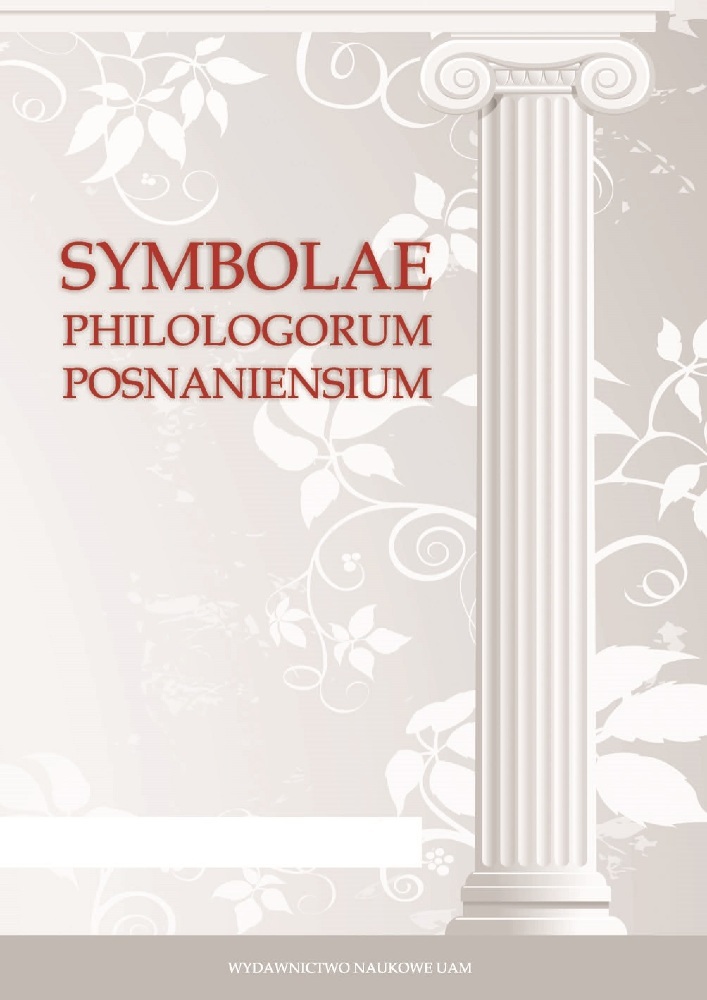Abstract
The main aim of this paper is to analyze several early-modern Neo-Latin poems written by Polish authors; the poems deal (in different ways) with old age. The poets undertake a kind of intertextual game with the reader, applying various stereotypes and clichés. On can speak about a “semiotic landscape” of old age. The authors taken into consideration are Jan Kochanowski, Grzegorz of Sambor, Thomas Treter (16th century) and Maciej Kazimierz Sarbiewski, Albert Ines (17th century).
References
Primary sources
Cicero. Letters and Treatises of Cicero and Pliny. Transl. by E. S. Shuckburgh. 1909. New York.
Cochanovius, I. Lyricorum Libellus. 1580. Krakow.
Cochanovius, I. Elegiarum Libri III, Eiusdem Foricoenia sive Epigrammatum Libellus.1584. Krakow.
Horace. Horace for Students of Literature. The ‘Ars Poetica’ and its Tradition. Ed. by O.B. Hardison, L. Golden. 1995. Gainesville.
Horace. The Complete Odes and Epodes. Transl. by David West. 2000. Oxford.
Ines, A. Lyricorum Centuria I Politicis, Ethicis, Poeticis Axiomatibus ac Problematibus instructa. 1655. Dantisci.
Kochanowski, J. Dzieła polskie. Ed. by J. Krzyżanowski. 1967. Warszawa.
Landino, C. Poems. Transl. By Mary P. Chatfield. 2008. Cambridge, MA.
Treasury of Polish Love: Poems, Quotations and Proverbvs: In Polish and English. Ed., tr. by M. Lipinski et al. 2001. New York.
Rabelais, F. The Histories of Gargantua and Pantagruel. Tr. by J. M. Cohen. 1955. Harmondswork.
Vigilantius Gregorius Samboritanus. Theoresis secunda seu Parentes. 1562. Cracoviae.
Vigilantius Gregorius Samboritanus. Poezje wybrane/Carmina selecta. Ed., tr. by E. Buszewicz. 2011. Warszawa.
Sarbiewski, M. C. Poemata omnia. Ed. by Thomas Wall. 1892. Staraviesiae.
Treter. T: Theatrum virtutum D. Stanislai Hosii, … per Thomam Treterum… exhibitum, 1686. Kraków.
Sarbiewski, M.C. : Casimirus Britannicus: English Translations, Paraphrases, and Emulations of the Poetry of Maciej Kazimierz Sarbiewski: Revised and Expanded Edition. Ed. by K. Fordoński, P. Urbański. 2010. London.
Secondary sources
Allen 2006: Allen, G. 2006. Intertextuality. London and New York: Routledge.
Ancona 1994: Ancona R., 1994. Time and the Erotic in Horace’s Odes. Durham: Duke University Press.
Anderson 1997: Anderson, W.S. “Commentary.” In: Metamorphoses: Books 1–5. Ed. by W. S. Anderson. Norman:University of Oklahoma Press.
Anderson 1999: Anderson, W. S. 1999. Horace’s Different Recommenders of Carpe Diem In C. 1. 4, 7, 9, 11. In Why Horace? A Collection of Interpretations. Ed. by W. Anderson, 37–43. Wauconda: Bolchazy-Carducci.
Baldick 1990: Baldick, Ch. 1990. The Concise Dictionary of Literary Terms. Oxford: Oxford University Press.
Barolini 2006: Barolini, T. 2006. Dante and the Origins of Italian Literary Culture. New York: Fordham University Press.
Borowicz 2016 (V): Borowicz, S. 2016. “W odwróconym świecie obrazu: wiek XVI (sztuki piękne).” In Anty-Beatrycze: studia nad kulturową historią obrazu pijanej i szalonej staruchy. Ed. by S. Borowicz, J. Hobot-Marcinek, R. Przybylska, 169–254. Kraków: Wydawnictwo Uniwersytetu Jagiellońskiego.
Borysowska 2010: Borysowska, A. 2010. Albert Ines (1619–1658): Jezuicki ‘vates Marianus’. Warszawa: IBL PAN.
Bowlby 2007: Bowlby, R. 2007. “Fifty-Fifty. Female Subjectivity and the Danaids.” In Freudian Mythologies: Greek Tragedy and Modern Identities. Ed. by R. Bowlby, 75–100. Oxford and NY: Oxford University Press.
Borowicz 2016 (VII): Borowicz, S. 2016. “W stronę realizmu – wiek XVII (sztuki piękne).” In Anty-Beatrycze: studia nad kulturową historią obrazu pijanej i szalonej staruchy. Ed. by S. Borowicz, J. Hobot-Marcinek, R. Przybylska, 313–378. Kraków: Wydawnictwo Uniwersytetu Jagiellońskiego.
Borowicz, Hobot, Przybylska 2016: Borowicz, S., Hobot-Marcinek, J., Przybylska, R. 2016. Anty-
Beatrycze: studia nad kulturową historią obrazu pijanej i szalonej staruchy. Kraków: Wydawnictwo Uniwersytetu Jagiellońskiego.
Buszewicz 2011: Buszewicz, E. 2011. “Preface”. In Grzegorz z Sambora / Vigilantius Gregorius Samboritanus, Poezje wybrane/Carmina selecta. Ed. and transl. by E. Buszewicz, 13–69…. Warszawa: Neriton.
Caldwell 1993: Caldwelll, R. S. 1993. “Aeschylus’ Suppliants: A Psychoanalytic Study.” In Modern Critical Theory and Classical Literature. Ed. by I. De Jong and J. P. Sullivan, 75–101. Leiden: Brill.
Commager 1962: Commager, S. 1962. The Odes of Horace: A Critical Study. New Haven: Yale University Press.
Chandler 2002: Chandler, D. 2002. Semiotics: The Basics. London: Routledge.
Danielewicz 1975: Danielewicz, J. 1975. “Pejzaż semiotyczny w Pieśniach Horacego.” Eos 63: 297–301.
Eco 1976: Eco, U. 1976. A Theory of Semiotics. Bloomington: Indiana University Press.
Hobot 2016: Hobot-Marcinek, J. 2016. “Dychotomie. Wiek XVI (literatura).” In Anty-Beatrycze: studia nad kulturową historią obrazu pijanej i szalonej staruchy. S. Borowicz, J. Hobot-Marcinek, R. Przybylska, 255–312. Kraków: Wydawnictwo Uniwersytetu Jagiellońskiego.
Janan 2001: Janan, M. 2001. The Politics of Desire: Propertius IV. Berkeley: University of California Press.
Milnor 2005: Milnor, K. 2005. Gender, Domesticity and the Age of Augustus: Inventing Private Life, Oxford.
Przybylska 2016: Przybylska, R. 2016. “Ta, która wie. Uwagi o kulturowym stereotypie ‘pijanej i szalonej staruchy’ w świetle danych językowych.” In Anty-Beatrycze : studia nad kulturową historią obrazu pijanej i szalonej staruchy. S. Borowicz, J. Hobot-Marcinek, R. Przybylska, 539–550. Kraków: Wydawnictwo Uniwersytetu Jagiellońskiego.
Salzman-Mitchell 2005: Salzman-Mitchell, P. B. 2005. A Web of Fantasies: Gaze, Image and Gender in Ovid’s Metamorphoses, Columbus. The Ohio State University Press.
Stone 2009: Stone, J.R. 2009. Latin for the Illiterati, Second Edition: A Modern Guide to an Ancient Language. New York–London: Routledge.
Van Leuven 2005: Van Leeuwen, Th. 2005. Introducing Social Semiotic. London: Routledge.
White 2013: White, M. Military Saints in Byzantium and Rus: 900--1500. Cambridge: Cambridge University Press.
Wilkinson 1951: Wilkinson, L.P. 1951. Horace and His Lyric Poetry. Cambridge: Cambridge University Press.
Woodman 1999: Woodman, A. J. 1999. “Horace, Odes II 3.” In Why Horace? A Collection of Interpretations. Ed. by William S. Anderson, 117–129, Wauconda: Bolchazy Carducci.
License
